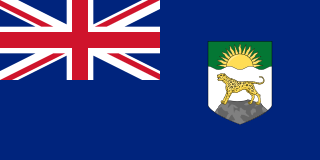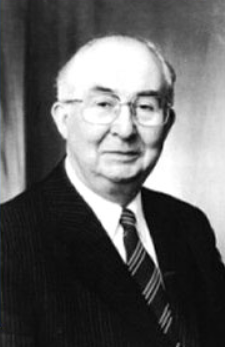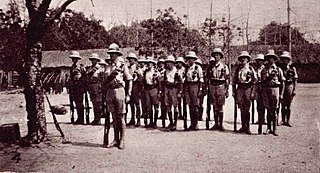
Nyasaland was a British protectorate located in Africa that was established in 1907 when the former British Central Africa Protectorate changed its name. Between 1953 and 1963, Nyasaland was part of the Federation of Rhodesia and Nyasaland. After the Federation was dissolved, Nyasaland became independent from Britain on 6 July 1964 and was renamed Malawi.

The British Central Africa Protectorate (BCA) was a British protectorate proclaimed in 1889 and ratified in 1891 that occupied the same area as present-day Malawi: it was renamed Nyasaland in 1907. British interest in the area arose from visits made by David Livingstone from 1858 onward during his exploration of the Zambezi area. This encouraged missionary activity that started in the 1860s, undertaken by the Universities' Mission to Central Africa, the Church of Scotland and the Free Church of Scotland, and which was followed by a small number of settlers. The Portuguese government attempted to claim much of the area in which the missionaries and settlers operated, but this was disputed by the British government. To forestall a Portuguese expedition claiming effective occupation, a protectorate was proclaimed, first over the south of this area, then over the whole of it in 1889. After negotiations with the Portuguese and German governments on its boundaries, the protectorate was formally ratified by the British government in May 1891.

John Nkologo Chilembwe was a Baptist pastor, educator and revolutionary who trained as a minister in the United States, returning to Nyasaland in 1901. He was an early figure in the resistance to colonialism in Nyasaland (Malawi), opposing both the treatment of Africans working in agriculture on European-owned plantations and the colonial government's failure to promote the social and political advancement of Africans. Soon after the outbreak of the First World War, Chilembwe organised an unsuccessful armed uprising against colonial rule. Today, Chilembwe is celebrated as a hero of independence in some African countries, and John Chilembwe Day is observed annually on 15 January in Malawi.

The Chilembwe uprising was a rebellion against British colonial rule in Nyasaland which took place in January 1915. It was led by John Chilembwe, an American-educated Baptist minister. Based around his church in the village of Mbombwe in the south-east of the colony, the leaders of the revolt were mainly from an emerging black middle class. They were motivated by grievances against the British colonial system, which included forced labour, racial discrimination and new demands imposed on the African population following the outbreak of World War I.
Joseph Booth was an English missionary working in British Central Africa and South Africa. In his 30s, Booth abandoned his career as a businessman and, for the rest of his life, he undertook missionary work for several Christian denominations including Baptist, Seventh Day Baptist and Seventh-day Adventist churches, and he was appointed a missionary by the Watch Tower Bible and Tract Society of Pennsylvania. Throughout his successive ministries, his defining beliefs were a radical egalitarianism, including a scheme of "Africa for the Africans"’ and, from 1898, Seventh-Day Sabbath (Sabbatarian) observance.
Henry Masauko Blasius Chipembere was a Malawian nationalist politician who played a significant role in bringing independence from colonial rule to his native country, formerly known as Nyasaland. From an early age Chipembere was a strong believer in natural justice and, on his return in 1954 from university in South Africa, he joined his country's independence struggle as a nationalist strategist and spokesman. In 1957, considering that the independence movement needed a strong leader similar to Kwame Nkrumah, and considering himself too young for this task, he joined with other young nationalists in inviting Hastings Kamuzu Banda to return to Nyasaland as the movement's leader.
A. L. Bruce Estates was one of three largest owners of agricultural estates in colonial Nyasaland. Alexander Low Bruce, the son-in-law of David Livingstone, acquired a large estate at Magomero in the Shire Highlands of Nyasaland in 1893, together with two smaller ones. On his death, these estates were to operate as a trust to bring Christianity and Commerce to Central Africa. However his two sons later formed a commercial company which bought the estates from the trust. The company gained a reputation for the harsh exploitation and ill-treatment of its tenants under a labour system known by the African term "thangata", which operated in the plantation cultivation of cotton and tobacco. This exploitation was one of the causes of the 1915 uprising led by John Chilembwe, which resulted in the deaths of three of the company's European employees. After the failure of its own cotton and tobacco plantations, the company forced its tenants to grow tobacco rather than food on their own land and significantly underpaid them. Following almost three decades of losses, the Magomero estate was in poor condition, but the company was able to sell it at a profit between 1949 and 1952 because the government needed land for resettlement of African former tenants evicted from private estates. The company was liquidated in 1959.
The Abrahams Commission was a commission appointed by the Nyasaland government in 1946 to inquire into land issues in Nyasaland. This followed riots and disturbances by tenants on European-owned estates in Blantyre and Cholo districts in 1943 and 1945. The commission had only one member, Sir Sidney Abrahams, a Privy Counsellor and lawyer, the former Attorney General of the Gold Coast, Zanzibar and Uganda, and the former Chief Justice, first of Uganda and then Ceylon. There had been previous reviews to consider the uneven distribution of land between Africans and European, the shortage of land for subsistence farming and the position of tenants on private estates. These included the Jackson Land Commission in 1920, the Ormsby-Gore Commission on East Africa in 1924 and, most recently, the Bell Commission on the Financial Position and Development of Nyasaland in 1938, but none of these had provided a permanent solution. Abrahams proposed that the Nyasaland government should purchase all unused or under-utilised freehold land on European-owned estates, which would then become Crown land, available to African farmers. The Africans on estates were to be offered the choice of remaining on their current estate as paid workers or tenants, or of moving to Crown land. These proposals were not implemented in full until 1952. The report of the Abrahams Commission divided opinion. Africans were generally in favour of its proposals, as were both the governors in post from 1942 to 1947, Edmund Richards, and the incoming governor, Geoffrey Colby. Estate owners and managers were strongly against it, and many European settlers bitterly attacked it.
William Jervis Livingstone (1865–1915) was the manager of the Magomero Estate in Nyasaland owned by A L Bruce Estates Ltd and was killed in 1915 during the uprising against colonial rule led by John Chilembwe. Livingstone, from the Isle of Lismore in Argyllshire, Scotland, was born in 1865 and appointed as manager of Magomero in 1893.
John Buchanan (1855–1896), was a Scottish horticulturist who went to Central Africa, now Malawi, in 1876 as a lay member of the missionary party that established Blantyre Mission. Buchanan came to Central Africa as an ambitious artisan: his character was described as dour and devout but also as restlessly ambitious, and he saw in Central Africa a gateway to personal achievement. He started a mission farm on the site of Zomba, Malawi but was dismissed from the mission in 1881 for brutality. From being a disgraced missionary, Buchanan first became a very influential planter owning, with his brothers, extensive estates in Zomba District. He then achieved the highest position he could in the British administration as Acting British Consul to Central Africa from 1887 to 1891. In that capacity declared a protectorate over the Shire Highlands in 1889 to pre-empt a Portuguese expedition that intended to claim sovereignty over that region. In 1891, the Shire Highlands became part of the British Central Africa Protectorate. John Buchanan died at Chinde in Mozambique in March 1896 on his way to visit Scotland, and his estates were later acquired by the Blantyre and East Africa Ltd.
Alexander Livingstone Bruce was a capitalist of Scottish origin, a director and major shareholder of A L Bruce Estates Ltd, one of the largest property owning companies in colonial Nyasaland. His father, Alexander Low Bruce, was a son-in-law of David Livingstone and urged his two sons to use the landholding he had acquired for philanthropic purposes. However, during over 40 years residence in Africa, Bruce represented the interests of European landowners and opposed the political, educational and social advancement of Africans. After the death of his elder brother in 1915, Alexander Livingstone Bruce had sole control of the company estates: his management was harsh and exploitative, and one of the main causes of the uprising of John Chilembwe in 1915. During the uprising, three of Bruce's European employees were killed and one of them, William Jervis Livingstone was held partly to blame for the revolt. Although Livingstone was carrying out Bruce's orders, Bruce, as a leading landowner and member of the governor's Legislative Council, escaped censure. Despite Bruce's striving for profits, A L Bruce Estates lost money but was saved from insolvency by the colonial government's need for land for resettlement following a famine in 1949. Shortly before his death in 1954, Bruce was able to sell the company's Nyasaland estates, repay its debts and realise a surplus.
Operation Sunrise was the name given to a police and military action conducted by the authorities in the Central African protectorate of Nyasaland which started on 3 March 1959, initially to detain and intern 350 individuals who were considered a potential threat to law and order in anticipation of the declaration of a State of Emergency. Although it is sometimes considered to involve only the incidents of 3 March, the Devlin Commission report is clear that it was one of two distinct operations by the security forces, reinforced from outside Nyasaland, involving the arrest and detention members of the Nyasaland African Congress. It involved not only those members of Congress initially arrested, but others arrested and detained without trial in the course of the emergency. The operation was described in some detail in the Devlin Commission report and that account has been amplified by Colonial Office documents not made available to the Devlin Commission.
George Simeon Mwase was a government clerk and later businessman and politician in colonial Nyasaland. He became politically active in the 1920s under the influence of the ideas of Marcus Garvey and his "Africa for the Africans" movement, and was instrumental in founding the Central Province Native Association in 1927. Mwase joined the Nyasaland African Congress (NAC) in 1944, soon after its formation, and later participated in its executive. By the late 1950s, the gradualism of Mwase and many of his contemporaries was rejected by a younger generation of more radical NAC members. He was marginalised and left the NAC and became a supporter of the Federation of Rhodesia and Nyasaland.
Charles Vincente Domingo was born in Mozambique but spent most of his life in northern Nyasaland, where he was educated at the Free Church of Scotland (1843-1900) mission at Livingstonia. He later became a teacher and licensed preacher there, but left the Free Church in 1908 over delays to his ordination and he later established an independent Seventh Day Baptist church and school in the Mzimba district. Domingo was one of three Africans sponsored by Joseph Booth who created independent churches in Nyasaland in the early 20th century, the others being John Chilembwe and Elliot Kamwana. Domingo did not favour armed revolt, as Chilembwe did, nor was he a charismatic preacher seeking rapid social change like Kamwana. He was a moderate social reformer who strongly criticised the inequalities of colonial rule, and a teacher who believed that Africans should run their own churches free of external supervision and use these churches to promote a high standard of education to create a cultured African elite, which would undertake its own social and political advancement. He failed because of inadequate resources in the poverty-stricken north of Nyasaland and through government suspicion of his motives, but he remains one of the pioneers of Malawi’s independence.
Landon Napoleon Cheek was an African-American Baptist missionary who served in the British Central Africa Protectorate, later renamed Nyasaland, between 1901 and 1906. There, he assisted John Chilembwe, the founder of the Providence Industrial Mission during the church's formative period. After returning to the United States, he became a Baptist pastor for almost 50 years. Cheek died in Chicago in 1964.
The siege of Mbombwe started on 25 January 1915 when soldiers of the Government of Nyasaland attacked the rebel capital of Mbombwe. The siege ended on the next day when troops from the King's African Rifles stormed the rebel capital after a fierce fight with the rebels.
The Livingstone Bruce Plantation Raid was an attack on the European owned and run cotton and tobacco plantation, which was situated at Magomero. The attack on the plantation was only major action of the ill fated Chilembwe uprising.

The ideas, people and events that contributed to John Chilembwe's motivation and influenced him to undertake the uprising in 1915 were considered by the Commission of Inquiry shortly after the rising was defeated, and have exercised historians of Malawi during much of the period since his death. Whether the dominant ideas were political, social, economic or religious and how these combined is unclear, because Chilembwe did not leave a detailed record of the reasons for his armed revolt. As he was an ordained Baptist minister, much attention has focussed on his religious ideas, whether these were orthodox or related to millennialism, the extent to which such potentially conflicting religious ideas existed, particularly in the period shortly before the rising, and the part that such beliefs played in the decision to revolt and the course of the uprising.

George "Sam" Albert Shepperson was a British historian and Africanist, noted particularly for his work on Malawian and African-American history. He was William Robertson Professor of Commonwealth and American History at the University of Edinburgh from 1963 until 1986. He was named Commander of the Order of the British Empire in 1989.

The Nyasaland Volunteer Reserve (NVR) was a British Colonial Auxiliary Forces unit raised in the British protectorate of Nyasaland. The British Central Africa Volunteer Reserve was formally established by the colonial government in 1901 and was renamed when the protectorate became Nyasaland in 1907. In the initial years the unit was little more than a rifle shooting club with no uniform and no military training. The NVR was placed on a more formal standing in 1908 under the Volunteer Ordinance. This implemented residency and racial requirements for membership and made provision for the unit to be mobilised by the governor. The unit was initially formed of four sections but grew to seven sections by 1914 and by 1930 the unit had ten.







